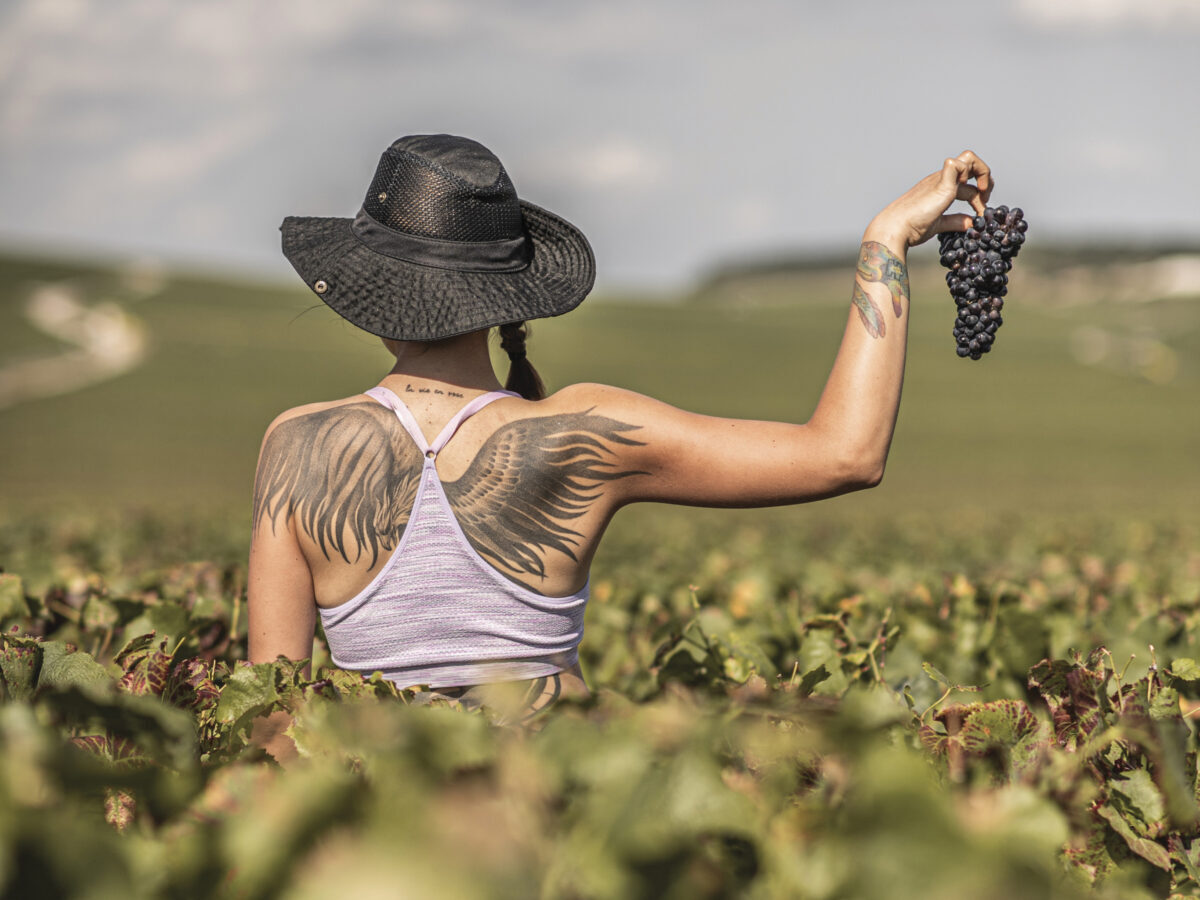Over 400 years ago, Pierre Pérignon joined the Benedictine Abbey of Hautvillers in the Champagne region of France. As a monk, he was given the honorary title of Dom and the prestigious position of cellar master. As the story goes, when Dom Pérignon created bubbly wine, he shouted, “Come quickly, I am tasting the stars!” The rest is history. Dom Pérignon was instrumental in inventing what is now known as Champagne, and he has a posthumous, eponymous Champagne, produced by Moët & Chandon, to prove it.
CHAMPAGNE’S DISCOVERY
It is hard to believe that, at one time, having bubbles in wine was considered a flaw. In trying to eliminate undesirable bubbles from red wine, Pérignon brought the invention of Champagne closer to fruition. During Champagne’s cold northeastern France winters, the temperatures halted the grape fermentation process, which left residual sugar and yeast. When the temperature rose, the fermentation began again, and carbon dioxide created pressure that formed bubbles when the wine was opened—if the bottle was opened, many lighter-weight bottles exploded along the way to perfect the process.
The Champagne region is the home of the iconic libation, but it is so much more for Champagne-based brand Taittinger’s President and CEO, Vitalie Taittinger. “[The Champagne region] is emblematic and unique; it represents celebrations and significant moments, but it is also about the wine, the knowledge, the terroir, and we cannot forget that.”
Due to Methode Traditionelle (formerly Méthode Champenoise), Champagne production is labor intensive. The technique requires a second fermentation in the same bottle, like what Pérignon had inadvertently had his finger on long ago. This is when the still wine becomes sparkling, known as “prise de mousse”—which means capturing the sparkle—because the yeast and sugar release alcohol and effervescence.
Dom Pérignon was not alone in his innovations that led to Champagne. The widow Clicquot of the Champagne house Veuve Clicquot developed the riddling process in the early 19th century to solve the problem of sediments in the wine caused by bottle fermentation. Disgorgement uses the pressure of the wine to eject just the sediment, so she stored the bottleneck down to keep the sediment in the bottle’s neck.
All genuine Champagne must spend at least 15 months maturing in the winemaker’s cellars before release, and vintage cuvées are aged for at least three years. Taittinger’s award-winning Comtes de Champagne Blanc des Blancs is aged for ten years to retain its subtle depth and complexity. By comparison, other grand marque houses age their top cuvées for only 5-6 years.
CHAMPAGNE UNITY
Historically, the region had three types of producers: Maisons, Vignerons, and Cooperatives. Maisons are the large Champagne houses, also known as Négociants, which often did not own vineyards but purchased the fruit from smaller winegrowers, known as Vignerons, who could also make wine with their fruit. Many small growers did not have winery operations, so they joined cooperatives, which often produced a blend. As the second largest vineyard and Domaine owner in the area with more than 700 acres of vines, Taittinger was among the first to have ultimate quality control from vine to bottle.
“When I arrived [17 years ago], the houses and the growers were much more separated. And now, you have many little winegrowers that have created some small brands, and they are sending their wine all over the world,” said Taittinger. “Today, we are one of the most united appellations. We have big houses, small growers, and cooperatives, and we are all behind the value of Champagne. This is the appellation of freedom—you can do what you want in terms of blending, but we still have consistency because we all work together for the quality.”
CHAMPAGNE INFLUENCE IN CALIFORNIA
There are several sparkling houses in California with their parentage in Champagne, such as Mumm, Moët & Chandon, Roederer, and Domaine Carneros (owned by Taittinger). Some of their roots go back to the Union des Maisons de Champagne, a group of Champagne houses known as the Grand Marques. The Grand Marques include Taittinger, Bollinger, Laurent Perrier, Moët & Chandon, and Louis Roederer.
“Taittinger and Domaine Carneros use the traditional method for making their bubbles, but the diverse terroir gives the wines their signature profiles,” Domaine Carneros CEO Remi Cohen explained. “Carneros and Champagne are classified into the same viticultural climate classification. But Champagne is on the cooler end of that spectrum, and we’re on the warmer end, so our wines naturally tend to have a little more fruitiness and a little less acidity. Technically, we do many things to retain acidity and minerality naturally. Not because we’re trying to seem like we’re Champagne, but to make a wine that can be appreciated worldwide for its minerality, brightness, and complexity.”
CHAMPAGNE SUBREGIONS
The Champagne region is divided into five subregions, each with its specialty: Aube, Côte des Blancs, Côte de Sézanne, Montagne de Reims, and Vallée de la Marne. Champagne typically uses three grape varieties—Chardonnay, Pinot Noir, and Meunier. Champagne makers produce white wine using predominantly black-skinned grapes–Pinot Noir and Meunier—by stopping the juice from macerating while in contact with the grape skins.
In Montagne de Reims, Pinot Noir dominates the plantings and wine. The variety comprises 41 percent of the vineyards, followed by Pinot Meunier, then Chardonnay. Montagne de Reims’ chalky soils give its Champagne a bold and fruity flavor. Côte des Bar (also known as The Aube) is also Pinot Noir dominant, and it is known for its sunny climate, which allows the variety to thrive. The area is known for Champagne with red fruit and spicy notes.
The Côte de Sezanne and Côte des Blancs have similar climates and soil, and both are known for elegant Chardonnay-based Champagne with citrus fruit and white flower flavors. The Côte des Blancs got its name due to the dominance of the white grape in the area—the Chardonnay grape comprises 97 percent of the plantings. Chardonnay is king here, and so is the Blanc des Blancs version of Champagne, one of the most coveted in the world. The Taittinger Comtes de Champagne (Counts of Champagne) Blanc de Blancs is its most exclusive and premium cuvée—in honor of Thibaud IV, whose seal proudly adorns every bottle of Taittinger. It is made with 100 percent Chardonnay from the five villages in Côte des Blancs with a Grands Cru classification for the Chardonnay grape (Avize, Chouilly, Cramant, Oger, and Mesnil-sur-Oger).
Finally, Valle de la Marne highlights Pinot Meunier, and due to its warmer climate, its Champagne tends to be full-bodied with fruity flavors.
VISITING CHAMPAGNE
The largest towns in Champagne are Reims and Épernay, where many large producers have tasting rooms, but smaller towns have tasting rooms, too. Some villages put on Fêtes du Champagne for local producers to open their doors for a walk-around-the-village tasting weekend.
Reims is the historical heart of the region, the former seat of the Archbishop of Reims and where French kings were crowned for centuries, leading to its nickname, Coronation City. Conquered by the Romans, Reims is still on the pilgrims’ path to Rome—Via Francigena—which begins in Canterbury, England, and ends at the tomb of St. Peter in Rome.
According to legend, the name Reims derives from “Remus,” the mythological brother of “Romulus,” the founder of Rome, and images of Romulus and Remus are carved into the Porte des Mars, an ornate third-century arch in Reims. The Gothic Notre Dame Cathedral of Reims is an architectural masterpiece. Nearby Champagne houses include Veuve-Clicquot, Mumm, Pommery, Taittinger, and Canard-Duchêne—a Domaine known for its uniquely artistic Champagne caves.
Épernay is built on chalky soil; taking advantage of this, many Champagne houses in Épernay have extensive caves—there are miles of them under the city. Moët et Chandon has the longest maze of underground tunnels, extending almost 20 miles. Prestigious Champagne houses offer tastings in gated 19th-century mansions along the highly manicured, legendary Avenue de Champagne. Perrier-Jouet, Boizel, Mercier and De Venoge are in Épernay. Outside Épernay, Abbey Saint-Pierre d’Hautvillers is the spot where Dom Pérignon developed the precursors to Champagne, and it is also where he is buried.
The Champagne region has produced some of the world’s most prestigious and coveted wines even through German occupation, bombardment and destruction, and a disjointed local industry. Today’s Champagne is reaping the rewards of all it has gone through; it has unified and raised the bar for what can be called Champagne worldwide. The resilience and soul of the singular wine region deserve several glasses of bubbly raised in the air to “Santé!”
Cohen expressed well why Champagne is so special. “It’s so uplifting to have a glass of bubbles and Champagne. It makes you smile; it’s hard to be in a bad mood. It’s got a vibrant acidity and texture. It brings joy to people. Our whole purpose is to bring joy, happiness, luxury, and elegance.”

